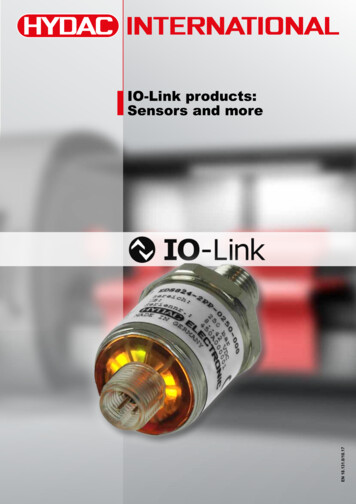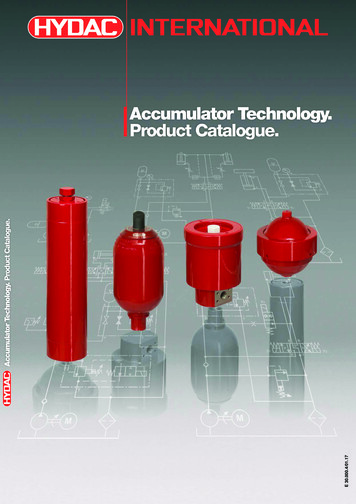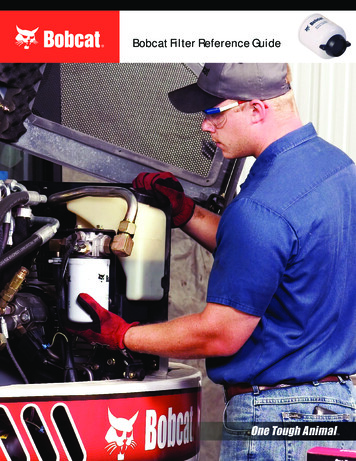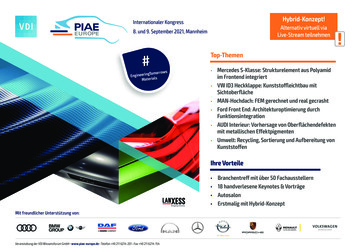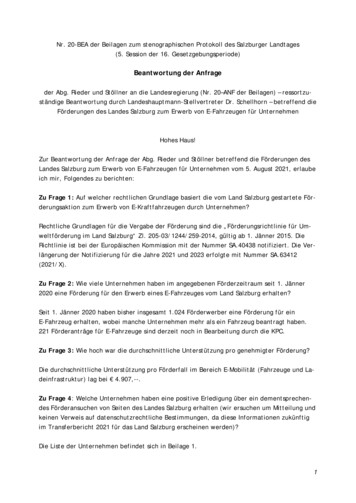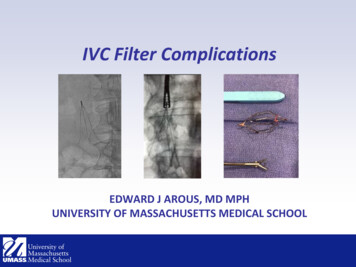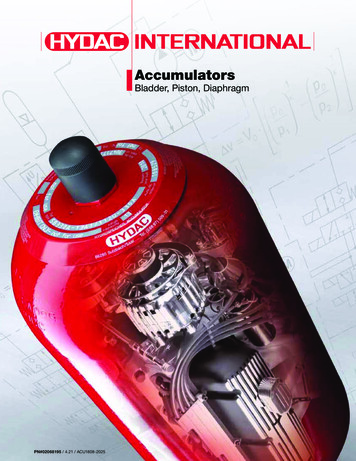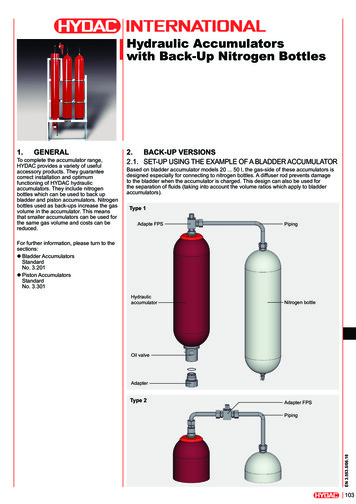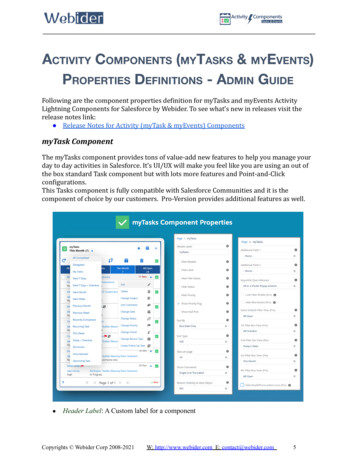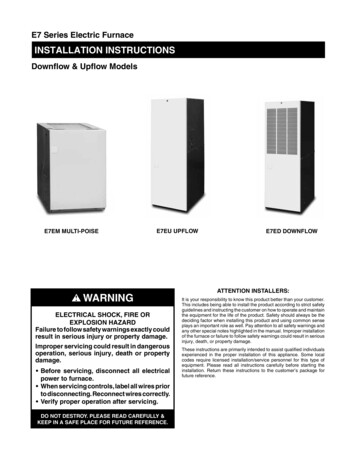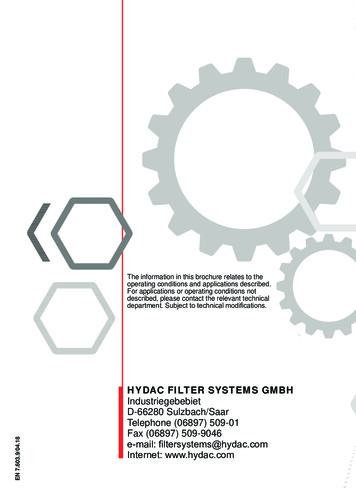
Transcription
EN 7.603.9/04.18The information in this brochure relates to theoperating conditions and applications described.For applications or operating conditions notdescribed, please contact the relevant technicaldepartment. Subject to technical modifications.HYDAC FILTER SYSTEMS GMBHIndustriegebebietD-66280 Sulzbach/SaarTelephone (06897) 509-01Fax (06897) 509-9046e-mail: filtersystems@hydac.comInternet: www.hydac.com
EN 7.603.9/04.18Fluid ControlContamination Handbook
Classification of base oils according to API 1509*API* GroupOil typeIIIIIIIVRaffinateHydratedbase oilSyntheticoilPAO 90% 90% 90%100%Amount of saturatedhydrocarbonsViscosity index80–12080–120 120-PolarityHighpolarityLess polarNearly nonpolarNodetailsSolubility of varnishHighMediumWeakWeakElectrical conductivityGoodBadVery lowLow* American Petroleum Institute (API)Composition ofhydraulic and lubrication oilsHydraulic andlubrication oils EN 7.603.9/04.18Base oil2Base oilAdditivesHydraulic &lubricationoils Additives** Example additives:––VI-improving agent––Pour-point loweringagent––Oxidation inhibitor––Corrosion inhibitor––Antiwear––Anti-foam
Classification of hydraulic oils according to DINOperating fluidMineral oil acc. toDIN 51524 orISO 11158Fire resistantacc. to DIN 5150 orISO 12922More rapidlybiodegradable acc. toISO 15380Lubricating oils acc. toDIN 51517CodeDensity at 15 C(kg/m3)H, HL, HLP, HV, HLPD860HFA/HFB1000HFC1090HFDR, HFDS1200HETG930HEES940HEPG1100HEPR890CL, CLP, CG860H1 lubricant“Food-grade (FG) lubricants”“Food-grade oil”Occasional, technically unavoidablecontact with foodstuffs not hazardousH2 lubricantContact with food not permitted. Useonly outside of the closed productionprocess.H3 lubricantSoluble oils for cleaning or rustprotection for machinesEN 7.603.9/04.18Food-grade oils acc. to NSF International3
Viscosity – Comparison ISO/SAEISO VG(DIN 51519)5Medium point viscosity (40 C) andapprox. viscosities in mm2/s atApproximateclassification of the0 CMotoroilsAutomobiletransmissionfluidsSAESAE40 C50 C100 C8 (1.7 E)4.641.5712 (2 E)6.852.01021 (3 E)1082.5153415113.55W225522154.510 0 W75 W15 W20 W80 W3015055015090154085 0250Viscosity index acc. to ISO 2909 – comparison to twomineral oilsThe higher the viscosity index of an oil, the smaller the change in viscosity in relation to the temperature.ViscosityHighOil AEN 7.603.9/04.18Oil B4High viscosity indexLow viscosity indexLowLow40 C100 CHighTemperature
Contamination typesSolidcontamination––Corundum, tinder, rust particles––Wear metals iron, copper, tin, zincetc.––Fibres, rubber particles, paintparticlesLiquidcontamination––Cooling water––SteamGel-likecontamination––Oil ageing/varnish––Oil mixtures––Additive separation (dropout)GaseouscontaminationEN 7.603.9/04.18––Air––Process gases5
Causes of contamination in oilCauseSolidLiquid––Installation contamination––Ambient contamination––Refilling of operating fluid––Internal wear processes––Oil ageing––Moisture from the ambient air––Leakage of cooling systems––Process water/process steam––Leakage of seals––High-pressure cleaner––Chemical processes(incineration, oxidation, neutralisation)––Oil ageing––Oil mixingGel-likeEN 7.603.9/04.18––Mixtures––Outgassing of oil6Gaseous
Consequences of ��Corrosion––Reduction in dynamic viscosity Reduction in lubricating film thickness Contact with surfaces Wear––Change in the oil properties Creation of acidic oil degradation products Formation of sludge Increase in speed of oil ageing––Cavitation damage––Reduction in lubrication gaps caused by deposits Increased friction and temperature Increased bearing wear––Malfunctions in valves Unstable control behaviour––Damage to dynamic seals Leakage––Blockage of filter elements Short filter life caused by sludge formation––Increased bearing temperature caused by caking––Cavitation––Oxidation––Local overheating of oil Increase in speed of oil ageing Control inaccuraciesEN 7.603.9/04.18Solid––Abrasive wear––Increased leakage––Component failure––Control inaccuracies––Blockage of control pistons––Short fluid service life7
Solid particle contaminationCleanliness classes acc. to ISO 4406Determining the ISO codeIn ISO 4406 particle counts are determined cumulatively, i.e. 4 µm (c), 6µm (c)and 14 µm (c) (manually by filtering the fluid through an analysis membrane orautomatically using particle counters) and allocated to key figures.EN 9202122232425262728 28Particle count/100 mlMore 0130,000,000250,000,000Up to and 30,000,000250,000,000Contamination load ��–0.1–0.20.51357/10204080–––––
Particle count per mlCleanlinessclassExample: ISO code 18/16/13Example:EN 7.603.9/04.18Larger thanLarger thanLarger than9
Solid particle contaminationCleanliness classes according to SAE AS4059Like ISO 4406, SAE AS 4059 describes particle concentrations in liquids. The analysismethods can be applied in the same manner as for ISO 4406 and NAS 1638.Size ISO 4402Calibration or optical counting* 1 μm 5 μmSize ISO 11171, calibration or electronmicroscope** 4 μm(c) 6 μm(c)ABSide code00019576003901520780EN 7.603.9/04.18Contamination 000623,000123,200,0001,250,000Particle sizes determined on basis of longest dimensionParticle sizes determined on basis of diameter of projected circle with same surface area
The SAE cleanliness classes are based on the particle size, the particle numberand the particle size distribution. The particle size determined depends on themeasurement process and calibration; consequently the particle sizes are labelled withletters (A–F).Max. particle concentration (particle/100 ml) 15 μm 25 μm 50 μm 100 μm 14 μm(c) 21 μm(c) 38 μm(c) 70 00019,6003,390512222,00039,2006,7801,020EN 7.603.9/04.181411
Solid particle contaminationCleanliness classes acc. to NAS 1638Like ISO 4406 and SAE AS 4059, NAS 1638 describes particle concentrations inliquids. Although NAS 1638 is no longer a valid industrial standard, it is often used inpractice because of its simplicity (just one key figure).The analysis methods can be applied in the same manner as ISO 4406.In contrast to ISO 4406, certain particle size ranges are counted in NAS 1638 andattributed to key figures.No. of particles in 100 ml sampleParticle size (µm)EN 7.603.9/04.18Cleanliness classes5–151215–2525–5050–100 ,40032,4005,7601,024
13EN 7.603.9/04.18
Solid particle contaminationEN 7.603.9/04.18Comparison photo for cleanliness classes14ISO 4406SAE AS 4059NAS 1638Class 14/12/9Class 4Class 3ISO 4406SAE AS 4059NAS 1638Class 15/13/10Class 5Class 4Magnification: x100Oil volume: 100 ml1 scale mark 10 μm
Class 16/14/11Class 6Class 5ISO 4406SAE AS 4059NAS 1638Class 17/15/12Class 7Class 6Magnification: x100Oil volume: 100 ml1 scale mark 10 μmEN 7.603.9/04.18ISO 4406SAE AS 4059NAS 163815
EN 7.603.9/04.18Solid particle contamination16ISO 4406SAE AS 4059NAS 1638Class 18/16/13Class 8Class 7ISO 4406SAE AS 4059NAS 1638Class 19/17/14Class 9Class 8Magnification: x100Oil volume: 100 ml1 scale mark 10 μm
Class 20/18/15Class 10Class 9ISO 4406SAE AS 4059NAS 1638Class 21/19/16Class 11Class 10Magnification: x100Oil volume: 100 ml1 scale mark 10 μmEN 7.603.9/04.18ISO 4406SAE AS 4059NAS 163817
EN 7.603.9/04.18Solid particle contamination18ISO 4406SAE AS 4059NAS 1638Class 22/20/17Class 12Class 11ISO 4406SAE AS 4059NAS 1638Class 23/21/18Class 13Class 12Magnification: x100Oil volume: 100 ml1 scale mark 10 μm
Examples of solid particle contaminationPredominantly rust,additives (white particles)Effect:––Strong oil ageing––Malfunctions in pumps, valves––Wear, mostly water in oilOil degradation productsEffect:––Filter blockage––Sludge accumulating in the systemMetal chips (flow chips)Magnification: x481 scale mark 45 μmEN 7.603.9/04.18Effect:–– Malfunctions in pumps, valves–– Seal wear–– Leakage–– Oil ageing19
Solid particle contaminationParticles/chips, bronze, brass orcopperEffect:––Malfunctions in pumps, valves––Oil ageing––Leakage––Seal wearGel-like residueEffect:––Filter blockage––Sludge accumulating in the systemSilicates resulting from absent orinsufficient breather filterEN 7.603.9/04.18Effect:––Strong wear on components––Malfunctions in pumps, valves––Seal wear20Magnification: x481 scale mark 45 μm
Paint particles (red/brown)Plastic particles (blue)Effect:––Malfunctions in pumps, valves––Seal wearFibres resulting from initialcontamination, open tank, cleaningcloths etc.Magnification: x481 scale mark 45 μmEN 7.603.9/04.18Effect:––Clogging of orifices––Leakage of poppet valves21
Solid particle contaminationCleanliness requirements of hydraulic and lubricatioLow/medium pressure 140 bar(Moderate conditions)ISO 4406Target cleanliness classFiltration rating 6/15/1215/13/102033 2020201033 2)18/15/1217/15/1215/13/1016/14/1110103 2)5Pumps/motorsGear or vanePistonVariable vaneVariable pistonDrivesCylinderHydrostatic drivesTest benchesValvesNon-return valveDirectional valveStandard flow control valvePoppet valveProportional valveServo valveBearingPlain bearing 3)Gears 3)Ball bearing 3)Roller bearing 3)Cleanliness requirements for dieselISO 4406 target cleanliness clasEN 7.603.9/04.18TankInjection system2218/16/1312/10/81) Poor conditions can result from flow rate fluctuations, pressure spikes, frequent cold starts,extremely high ingress of contamination or the presence of water.2) Two or more system filters of the recommended rating may be requiredto achieve and maintain the desired target cleanliness level.3) Valid for the average diameter range
on oilsHigh pressure140 to 200 bar(Low/medium underbad conditions1)Very high pressure 200 bar(High pressure under badconditions1)ISO 4406Target cleanliness classFiltration rating μmISO 4406Target cleanlinessclassFiltration rating /15/12not required16/14/1153not required3 2)19/17/1416/14/1115/13/10103 2)3 2)18/16/1315/13/1015/13/1053 2)3 201010533 105533 2)3 2)not requirednot requirednot requirednot requirednot requirednot requirednot requirednot requirednot requirednot requirednot requirednot requirednot requirednot requirednot requirednot requiredssFiltration rating µmFor system cleanliness, we recommend using one class better than the cleanliness required forthe most easily damaged component. Filling/rinsing filtration at least one filtration rating finer thanthe system filter. According to DIN 51524 a cleanliness of ISO 21/19/16 must be provided for freshhydraulic fluid.EN 7.603.9/04.185 µm (single pass elements)5 µm (single pass elements)23
Liquid contaminationSaturation pointDissolved waterBelow the saturation point––Water is present in the oil in dissolved form – like the waterthat is present in humid air.––All water molecules are deposited on polar oil components(e.g. additives, particles, oil degradation products)Free waterAbove the saturation point––Water is present as an emulsion (similar to fog), with ultrafine water droplets distributed throughout the oil in a stablesuspension. This causes clouding of the oil.––Water is present in free form, normally settling on the base.Saturation limit of water in oil120024Water content [ppm]EN 7.603.9/04.181000800600Free andemulsified water4002000-20Dissolved water-10010Temperature [ C]20304050
Water saturation curvesWater saturation [ppm]Group VDieselGroup IVGroup I, II, IIITemperature [ C]Water content [%]Source: FAG/SchaefflerEN 7.603.9/04.18Relative life expectancyof roller bearingsLife expectancy of bearings in relation towater content25
Gel-like contamination (oil degradation product/varnish)Varnish – analysis procedureLaboratory analyses – varnish:––MPC (membrane patch colorimetry)based on ASTM D7843-12Laboratory analysis – specific:––Particle measurement at 20 C and 80 Cbased on ISO 11500Particle count in an oil sample26At 80 CCleanliness class acc. to ISO 4406EN 7.603.9/04.18Particle count per 1 mlAt 22 CParticle difference
Example imagesValve piston withdepositsOil samples at room temperature withslight cloudingFilter membrane before andafter varnish separationCoupling sleeveGear, planetary stageTurbine radial & axial bearingEmergency oil pumpGear teethOil cooler fins (on oil side)EN 7.603.9/04.18Typical images of depositsin a steam turbine27
Gaseous contaminationSolubility of air in oilDissolved air quantity [vol.%]Relationship between pressure and temperatureAt 20 C and 1 bar(atmospheric pressure)Approx. 10 % dissolved air in 100 litres oil,approx. 10 litres air80 C20With pressure reduction to0.8 barOnly 8 % of air soluble in 100 litres oil,2 litres of air released!20 C10800,50,81,01,52,02,5Pressure [bar]Fluid ageingcaused by cavitationEN 7.603.9/04.18Gas bubble28RangePressureAFHI1 bar69 bar138 bar207 barTemperature38 C766 C994 C1140 COil carbon/varnish
Air release capacity for fresh oilsLimit values of typical standard for fresh oilISO VG/type324668100(150)( 320)Turbine oilDIN 51515, ISO 8068556xxxHydraulic fluid HLP/HMDIN 51524/2, ISO 11158510132132xEN 7.603.9/04.18Example images29
Product portfolioContamination typeMeasurement devices (online/offline)ContaminationSensorCS 1000Metallic ContaminationSensorMCS 1000ContaminationSensor ModuleEconomy CSM-EFluidControl UnitFCU 1315SolidAquaSensorAS 1000 & AS 3000LiquidContaminationSensor ModuleEconomy CSM-EEN 7.603.9/04.18Gel-like30GaseousFluidControl UnitFCU 1315
Typical separation method/oil conditioning devicesFilter elementMobileFiltration UnitMFUVacuum evaporationFluidAqua MobilFAMCold filtrationVarnishElimination UnitVEU-FOffLine FilterOLF 5CoalescenceOffLine Filter BiDirectionalOLFBDSuperabsorberOffLine SeparatorOLSMobileFiltration UnitMFULowViscosity HousingCoalescer Diesel LVH-CDAquamicronAMIon exchangerIon eXchange UnitIXUFluidAqua MobilFAMOXiStopOXSEN 7.603.9/04.18Vacuum drying31
HYDAC FILTER SYSTEMS GMBH . Industriegebebiet D-66280 Sulzbach/Saar Telephone (06897) 509-01 Fax (06897) 509-9046 e-mail: filtersystems@hydac.com Internet: www.hydac.com. . automatically using particle counters) and allocated to key figures. Solid particle contamination: ISO code:
